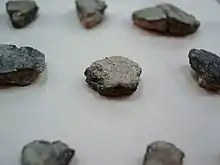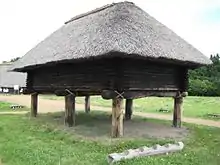Jōmon Archaeological Sites in Hokkaidō, Northern Tōhoku, and other regions
Jōmon Archaeological Sites in Hokkaidō, Northern Tōhoku, and other regions (北海道・北東北を中心とした縄文遺跡群) is a group of Jōmon-period archaeological sites in Hokkaidō and northern Tōhoku, Japan, that in 2009 were submitted jointly for future inscription on the UNESCO World Heritage List, under criteria iii and iv. While the principal focus of the serial nomination is upon fifteen sites in southern Hokkaidō, Aomori, Iwate, and Akita, other prefectures are also concerned. Currently the submission resides on the Tentative List.[1][2][3]
Sites
See also
- List of National Treasures of Japan (archaeological materials)
- List of Historic Sites of Japan (Hokkaidō)
- List of Historic Sites of Japan (Aomori)
- List of Historic Sites of Japan (Iwate)
- List of Historic Sites of Japan (Akita)
- World Heritage Sites in Japan
References
- "Jômon Archaeological Sites in Hokkaidô, Northern Tôhoku, and other regions". UNESCO. Retrieved 12 June 2012.
- "「北海道・北東北を中心とした縄文遺跡群」の世界文化遺産登録をめざして" [Towards World Heritage Inscription of "Jōmon Archaeological Sites in Hokkaidō, Northern Tōhoku, and other regions"] (in Japanese). Hokkaidō Government Board of Education. Archived from the original on 8 May 2013. Retrieved 12 June 2012.
- "北海道・北東北を中心とした縄文遺跡群" [Jōmon Archaeological Sites in Hokkaidō, Northern Tōhoku, and other regions] (in Japanese). Aomori City. Archived from the original on 20 April 2012. Retrieved 12 June 2012.
- "入江・高砂貝塚" [Irie-Takasago Shell Mound] (in Japanese). Agency for Cultural Affairs. Retrieved 12 June 2012.
- "北黄金貝塚" [Kitakogane Shell Mound] (in Japanese). Agency for Cultural Affairs. Retrieved 12 June 2012.
- "鷲ノ木遺跡" [Washinoki Site] (in Japanese). Agency for Cultural Affairs. Retrieved 12 June 2012.
- "大船遺跡" [Ōfune Site] (in Japanese). Agency for Cultural Affairs. Retrieved 12 June 2012.
- "Kakinoshima Site". Jomon Prehistoric Sites in Northern Japan. Retrieved 30 November 2020.
- "大平山元I遺跡 -日本最古の土器出土-" [Ōdaiyamamoto Ichi Site - Excavation of Japan's Earliest Earthenware] (in Japanese). Aomori Prefecture. Retrieved 12 June 2012.
- "田小屋野貝塚" [Tagoyano Shell Mound] (in Japanese). Agency for Cultural Affairs. Retrieved 12 June 2012.
- "亀ヶ岡石器時代遺跡" [Kamegaoka Stone Age Site] (in Japanese). Agency for Cultural Affairs. Retrieved 12 June 2012.
- "三内丸山遺跡" [Sannai-Maruyama Site] (in Japanese). Agency for Cultural Affairs. Retrieved 12 June 2012.
- "青森県三内丸山遺跡出土品" [Excavated Artefacts from the Sannai-Maruyama Site] (in Japanese). Agency for Cultural Affairs. Retrieved 12 June 2012.
- "二ツ森貝塚" [Futatsumori Shell Mound] (in Japanese). Agency for Cultural Affairs. Retrieved 12 June 2012.
- "小牧野遺跡" [Komakino Site] (in Japanese). Agency for Cultural Affairs. Retrieved 12 June 2012.
- "Omori Katsuyama Stone Circle". Jomon Prehistoric Sites in Northern Japan. Retrieved 22 September 2020.
- "是川石器時代遺跡" [Korekawa Stone Age Site] (in Japanese). Agency for Cultural Affairs. Retrieved 12 June 2012.
- "陸奥国是川遺跡出土品" [Excavated Artefacts from the Korekawa Site] (in Japanese). Agency for Cultural Affairs. Retrieved 12 June 2012.
- "大湯環状列石" [Ōyu Stone Circle] (in Japanese). Agency for Cultural Affairs. Retrieved 12 June 2012.
- "伊勢堂岱遺跡" [Isedōtai Site] (in Japanese). Agency for Cultural Affairs. Retrieved 12 June 2012.
- "御所野遺跡" [Goshono Site] (in Japanese). Agency for Cultural Affairs. Retrieved 12 June 2012.
External links
This article is issued from Wikipedia. The text is licensed under Creative Commons - Attribution - Sharealike. Additional terms may apply for the media files.





